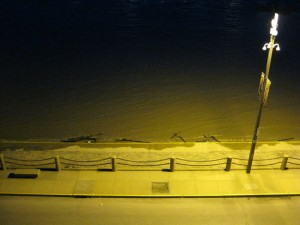I love photographing the most famous monument in St. Louis, Missouri, the Gateway Arch. I’ve spent time at the riverfront downtown St. Louis for the past two nights. Last night, it was for a business meeting, where I shot this panorama (click the photos for a expanded views):
Tonight, my wife and daughters returned to watch the sun set–the river water was high, making the river look much larger than usual. I focused on the sky, though, including this vertical panorama:
 It was taken by standing directly under the arch and shooting up. For a thicker version of the arch, move up to within 30 feet of one of the legs and you’ll end up with this:
It was taken by standing directly under the arch and shooting up. For a thicker version of the arch, move up to within 30 feet of one of the legs and you’ll end up with this:
 As the sun went down, I shot this silhouette of the south leg and some of the visitors.
As the sun went down, I shot this silhouette of the south leg and some of the visitors.
 Shortly thereafter, while walking back to our car, my 11-year old daughter JuJu was struck by the color of the river bank lit by the streetlight. That image is the somewhat eerie ending to this little gallery:
Shortly thereafter, while walking back to our car, my 11-year old daughter JuJu was struck by the color of the river bank lit by the streetlight. That image is the somewhat eerie ending to this little gallery:
 None of this is difficult to do; it’s all there for the taking. BTW, I used a consumer grade camera (the Canon Powershot SD1100IS).
None of this is difficult to do; it’s all there for the taking. BTW, I used a consumer grade camera (the Canon Powershot SD1100IS).
For those interested in the geometry of the arch, Wikipedia offers this:
This hyperbolic cosine function describes the shape of a catenary. A chain that supports only its own weight forms a catenary; in this configuration, the chain is strictly in tension. An inverted catenary arch that supports only its own weight is strictly in compression, with no shear. The gateway arch itself is not a catenary, but a more general curve called a flattened catenary of the form y=Acosh(Bx); a catenary is the special case when AB=1. While a catenary is the ideal shape for an arch of constant thickness, the gateway arch does not have constant thickness as it is narrower near the top.


